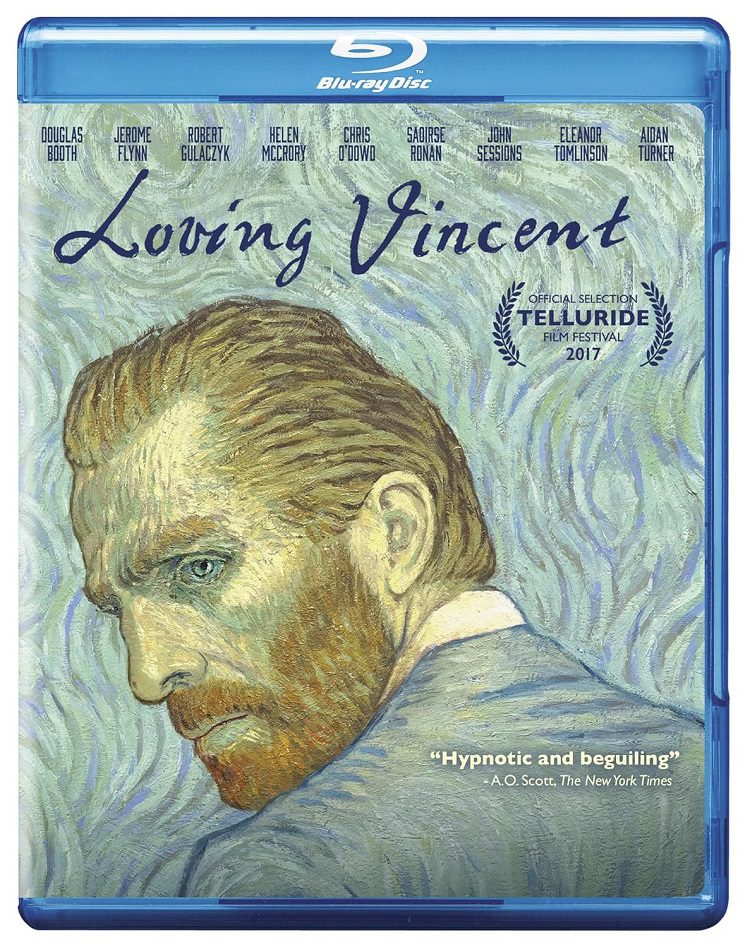
At the end of each Laika Studios feature film (Coraline, Kubo & the Two Strings, etc.), we get a time-lapsed, behind-the-scenes look into how the preceding movie was made, and we’re shown how much detail and hard work was put into crafting one particular scene. I kind of wish there was something like that at the end of Loving Vincent, a new biopic about the late Vincent van Gogh that was made entirely with oil paintings on canvas. Granted, you can find clips online, but having it readily available for viewing during the credits, especially after something as experimental and as unique as this, would have been a nice way to show the people whose interests are instantly piqued.
Every single one of Loving Vincent‘s 65,000 frames was hand-crafted by 125 professional oil painters. It’s a daunting task, one that took seven years from the time the project started to its completion. The end result is something that is jaw-droppingly beautiful, and unlike anything that has ever been seen before. Given the amount of work that went into creating Loving Vincent, I doubt there will be another film of its kind. But I’m also glad that a movie like this exists. It’s a terrific showcase on the power of filmmaking and how, no matter how many years it takes, anybody with a vision for how they want to tell a story can make it happen.
Loving Vincent takes place one year after van Gogh’s mysterious death. The initial ruling is that the artist committed suicide. Or was he, in fact, murdered? That’s what Armand Roulin (Douglas Booth) is hoping to find out. When assigned by his postmaster father (Chris O’Dowd) to deliver a letter to Vincent’s brother, Theo, Armand discovers that Theo has also passed away. To better understand someone like Vincent van Gogh, Armand does some of his own detective work by interviewing the people closely associated with the late artist. These people include van Gogh’s paint supplier, Pere Tanguy (John Sessions), his doctor (Jerome Flynn), and the doctor’s daughter (Saoirse Ronan). Each of them has a different perspective on how van Gogh was as an individual, and what exactly was the cause of his death.
The quasi-detective story isn’t particularly as inventive as the film’s style, and, at times, feels like it weighs the movie down in certain spots. Flashbacks rendered in black and white come here and there, making it feel a bit disjointed in some areas. Had this been more of a focused biopic on van Gogh, Loving Vincent may have had a smoother narrative flow to go along with its outstanding visuals.
The cast is strong, O’Dowd especially, and it’s fun seeing them in animated form like this, even if the story doesn’t quite meet the same level as the film’s visual aspect. At times, Loving Vincent is reminiscent of Richard Linklater’s bonkers rotoscope classics of the 2000s, Waking Life and A Scanner Darkly. That’s because the film was shot in live action format with the actors and green screen, and then each frame was later painted with oil on canvas. Unlike Linklater’s films, Loving Vincent isn’t fully done with computer-generated effects. There are some here, but it’s barely noticeable, since the actual oil painted imagery overshadows all of it.
You are literally watching numerous paintings come to life before your eyes. If you ever thought about how Van Gogh’s “Starry Night” would look while in motion, directors Hugh Welchman and Dorota Kobiela show you. If you ever had an imagining that one of Van Gogh’s well known characters would start talking, you get that here, too. It’s mesmerizing work, and watching it all unfold in front of you is a treasure. Albeit, it does take some time to get completely settled into the chaotic nature of Loving Vincent‘s craft. Some of it starts off a bit dizzying at first, but then, when we get used to its visual aesthetics, it becomes a real treat.
Loving Vincent may have fared better had the story been more focused on its actual subject than taking the generic crime investigation scenario. But one has to appreciate the amount of effort to get something this visually striking made into a full-length feature. It’s painstaking work, but it’s also a labor of love. And, for that, it’s worth checking out.
383654122X